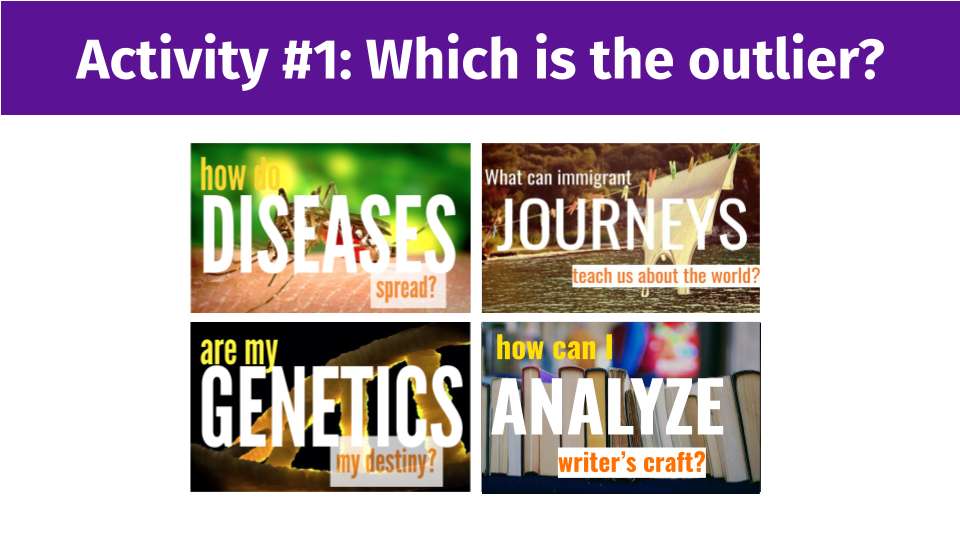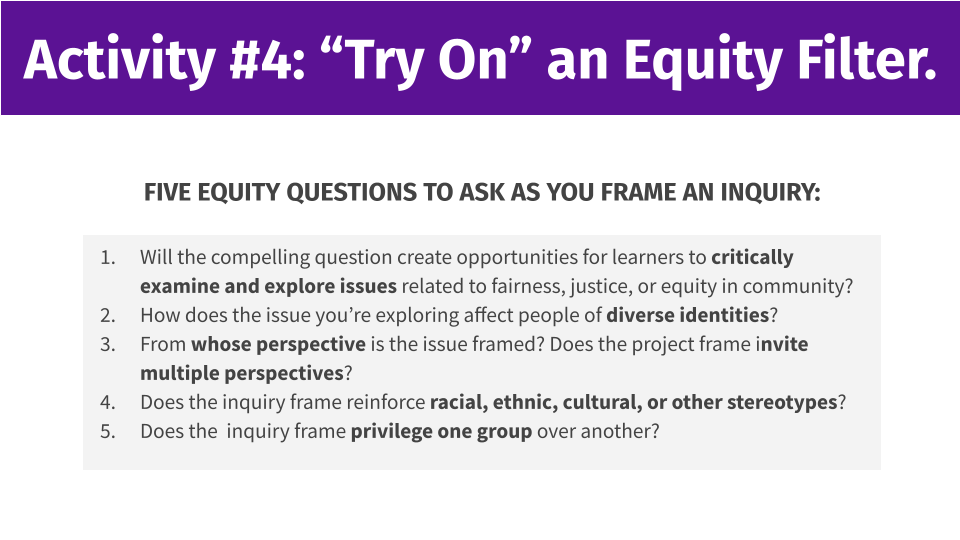Maybe you’re a total rock star at creating compelling questions that frame projects or units of study. In fact, maybe you’re so advanced, your students are framing their own incredible compelling questions and carrying out their own inquiry plans with only little coaching support from you. In fact (!), maybe your entire instructional team has the art and science of question-framing down so well, it’s basically happening in their sleep.
If that’s you, see you some other time.
But if that’s not you, and you could use some support turning your essential questions into something much more engaging, relevant, and inspiring, we think you’re in the right place.
As another #JustOneThing, reDesign is sharing its Design Guide to Creating Compelling Questions as an open resource for all.
Language-setting, please?
So what do we mean by compelling question? It’s similar to an essential question, but there’s just one of them, it frames the entire project or unit, and it meets these criteria:
- Relevant to learners’ lives and interests
- Important: It points toward important, transferable ideas and concepts
- Challenging: Open-ended, requires high-order thinking, and involves multiple pathways or solutions
- Written like a hook: short, provocative, and written to and for students!
- Equity-focused: It creates an authentic context for investigating issues related to fairness, justice, or equity in community
So what’s in the design guide?
In the design guide, we share examples of compelling questions, specific steps you can take to develop a compelling question, and finally, a set of activities you can facilitate with an instructional team to help ensure shared understanding and alignment on what makes a compelling question.
I’ll share two high-lights, for a little sneak peek.
The first high-light is of one of the teacher-team activities for calibrating around quality question framing. It’s a very simple, “Which is the outlier?” prompt. It’s a helpful activity to start with; it’s constructivist, and gets people talking. What do these have in common? Which one really is the outlier? Doesn’t it depend on the audience? What do we like or not like about these example questions? You could swap out these examples with others, if you’d like.

A second high-light from the design guide is another one of these recommended activities for calibrating a team, but it can also be used individually as you critique your own work. The activity involves applying an “equity filter” or set of questions to help you consider the impacts of privilege, bias, and ethnocentrism. The five questions are:
- Will the compelling question create opportunities for learners to critically examine and explore issues related to fairness, justice, or equity in community?
- How does the issue you’re exploring affect people of diverse identities?
- From whose perspective is the issue framed? Does the project frame invite multiple perspectives?
- Does the inquiry frame reinforce racial, ethnic, cultural, or other stereotypes?
- Does the inquiry frame privilege one group over another?

I’ll close by sharing how important I believe a compelling question really is to the learning process: not only by optimizing engagement for learners, but by creating opportunities to connect our disciplinary content to authentic and important issues in the world. Most importantly, if you’re an educator committed to antiracism and inclusion, a compelling question is a golden opportunity cultivate critical consciousness as learners critically examine the world and explore opportunities to disrupt inequities and make positive change.
I’ll never forget back in the fall of 2016, I had the opportunity to work with a teacher early in her career who, after a single conversation about question-framing, was willing to reframe her upcoming unit of study around an issue she knew her students would care deeply about: the travel ban on Muslim-majority countries. Not more than two months later, she reached out to tell me that she’d never seen her students so engaged in her class, and some of her students were organizing a fundraiser to support the cause.
Compelling questions are not just about marketing, and repackaging academic standards with a catchy hook (though I am all for repackaging academic standards with catchy hooks). Compelling questions are powerful levers for meaningful, joyful, and empowering learning experiences for young people.
So, let’s do more of that.
We hope you enjoy the Design Guide to Creating Compelling Questions. As always, we welcome your feedback or suggestions. Drop us a line at hello@redesignu.org.

